
Ventilation system maintenance in Utena
About this service
Ventilation system maintenance
A poor ventilation system directly affects the quality of your life, so keeping it well-functioning is essential. Professional inspection and maintenance are key in ensuring the system keeps working properly and efficiently for longer. On the Discontract app, you will be able to easily find professionals to take these worries off your hands.
Learn morePopular PROs
Order this service via Discontract App
Try the Discontract mobile app for free now. Order services quickly and conveniently, and choose service providers based on their ratings, prices, and work experience. Do you provide services? Join our professionals and receive payments for your work within 24 hours.

About this service
Your ventilation system is delicate. But not so delicate that it couldn’t bare the elimination of an old part. Here's how to troubleshoot your ventilation system.
What’s in your HVAC system (and how to troubleshoot).
Part 1: The circuit breaker: what powers your AC unit.
You can make toast, watch TV and blow dry your hair at the same time without burning your house down — and that’s because of your circuit breaker. When electrical wiring has too much current flowing through it, your circuit breaker cuts the power before something surges, sparks or starts a fire. Basically, your circuit breaker is your home’s first line of protection when equipment goes haywire and wires get crossed.
Your air conditioning system includes a lot of wires (and has its own switch on your circuit breaker), so if your circuit breaker trips, your AC will shut off and the airflow stops. When this happens, hit the reset button (or switch) on your circuit breaker, and your AC and heating systems will roar back to life.
If your circuit breaker keeps tripping, odds are you’re dealing with a problem. Either your circuit breaker needs to be serviced, or your AC’s larger electrical system does. No matter which it is, it’s time to bring in a professional.
Part 2: The cooling unit: the evaporator coil and condenser coil.
The evaporator coil is one of two core components that make up your air conditioner or heat pump. It’s filled with a compressing agent that absorbs heat from the air inside your house and moves it via refrigerant lines to your outdoor unit, where the condenser coil cools it back down. Air moves over the evaporator and condenser coils with the help of a blower fan, exchanging hot air with cold air (and in the case of a heat pump, cold air for hot) to change the temperature inside your home.
Your AC system has a lot of coils. Here’s how to tell the main two coils apart. The evaporator coil is located inside your home in your air handler (the thing with a fan and an air filter that circulates air in your home). The condenser coil, on the other hand, is located outside of your home in the metal unit that cools warm air off with refrigerant and cycles it back into the house.
Part 3: The blower motor: inside your air ducts.
Your air conditioning system is controlled by fans with motors — motors that can break, get jammed and fail. The two main fan motors to know are the blower motor that pushes air around the inside of your home (through vents and ducts) and the air conditioning condenser that cools off warm air that’s been pumped in from the inside of your home.
If your motor stops working, your AC and heating systems stop working. To do some basic troubleshooting, check under the cover of the motor for any signs of dust or overheating — both of which can cause your fans to go on hiatus.
Part 4: The air filter: key to maintaining indoor air quality.
It might look simple, but that rectangle sliding in and out of your HVAC system is actually doing a lot of work all the time. Before you breathe it in, the air that circulates in your air conditioning and heating systems gets pushed through a densely woven screen of fiberglass and cloth to clear it of mold, dander and other potentially dangerous buildup.
A dirty air filter can wreak havoc on your HVAC system, causing malfunctions, blocking airflow, dirtying your air ducts and negatively affecting the air quality in your space. You should check your air filter every other month by shining a flashlight through it — if you can’t see light on the other side, it’s time to put in a new one.
Part 5: The air conditioner unit: the outdoor appliance.
Let’s talk more about that outdoor unit we’ve been mentioning — your air conditioning unit. It’s an appliance in two parts — a compressor and a heat exchanger — installed just outside of your home on a concrete slab to keep it level. The most common air conditioning unit problems are actually concrete slab problems. If the ground beneath the concrete sinks (and it can), the AC unit on top of will be thrown out of balance. And that means damage to your central air conditioning system.
Stay ahead of problems by checking your AC unit regularly for signs of sinkage (especially between seasons, when the ground is soft), and correct the leveling ASAP where and when gravity hits. If you don’t want to do this, you can hire a ventilation technician to come out every few months to inspect it for you.
Part 6: The control board: thermostat settings.
Most home systems have a user-friendly control post — for your ventilation system, that’s your thermostat. Depending on how it’s programmed, your thermostat might not be operating at peak efficiency (i.e. it’s set to keep your home warmer or cooler than it has to be). It’s also possible for your thermostat to go out, making it impossible to control the temperature inside your home.
If you’ve checked the batteries and your thermostat just isn’t working, hire a professional to put in a new one.
3 fixes to try for common HVAC problems.
Tip #1: Make sure all the registers in your home are wide open.
Registers control the airflow from your heating or cooling system into your home. It’s a grate-like metal plate that covers a vent opening.
If you don’t feel any air but your thermostat is on, check your register. If the grates are closed, it’s as simple as opening them back up to let the air in. Gotta love an easy fix.
Tip #2: Check your furnace filter for buildup or clogs.
Your furnace filter protects your furnace (and the blower fan) from the dust, hair and dirt in your duct system. If it’s clogged, the reduced air flow into your furnace can cause serious issues with your evaporator coil. Cleaning your filter out between seasons will keep debris from building up — and save you a maintenance bill.
Tip #3: Clean off your condenser coils.
Bad things happen when dust and grime build up on the condenser coils in your outdoor AC unit. If the coils get even a little dirty, they lose efficiency, making heat build up in your compressor. When this happens, your system will shut down, stopping cooling functions entirely.
Check your condenser coils every few months and wipe them off even if they look clean. A thin layer of dust can cause you real problems in the long run.
How much does ventilation maintenance cost?
An expert of heating, ventilation and air conditioning will solve any kind of issue of your system. The cost of the maintenance of the system will depend on the type of services it needs: whether a simple inspection and adjustment of the system will do, or will it be necessary to replace the air filter or other old part with a new one. In this case, the check up of the system itself will take longer. Therefore, in order not to increase the cost due to many failures, it’s recommended to change the contaminated air filters regularly and keep the whole system clean, which will reduce maintenance costs.
Find a ventilation system pro near you
Do not wate until your ventilation system starts falling apart – hire an expert today and make sure the air you breath in is perfect quality all year round.
